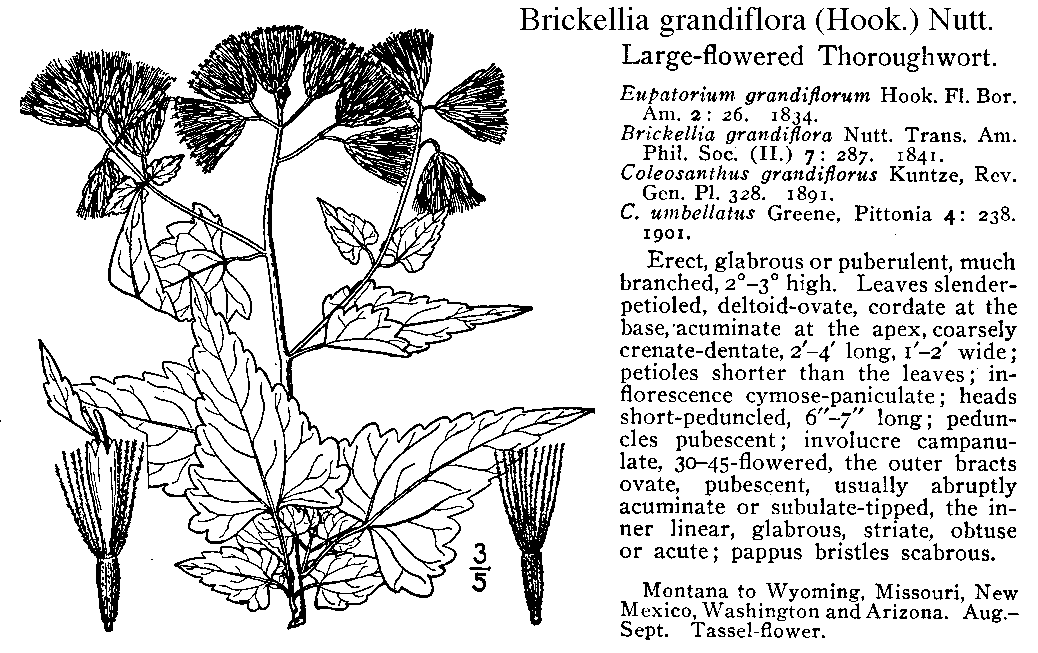Scientific name: Brickellia grandiflora, Brickellia spp.
Family: Asteraceae
Other names: Brickellia, Prodijiosa, Bricklebush, Hamula, Amula
Habitat: Prodigiosa is known to grow in Mexico, Honduras and the United States (EOL).
Parts used medicinally
Roots, Leaves

Brickellia is in flower August – September.
Indication
Tonic, stomach and digestive problems, anti-diabetic
Unlike other members of its genus, it has a sticky texture to its leaves. Brickellia incana, Brickella californica and Brickellia cavanillesii may be interchangeable species.
A hexane extract of B. veronicaefolia was shown to have a substantial hypoglycemic effect in diabetic and healthy mice. The mechanism of action was not elucidated but based on historical accounts of long-term, safe use of the plant; it is most likely an insulin sensitizer.
An additional benefit is that its flavonoids have been demonstrated to inhibit aldose reductase, suggesting it could have a benefit beyond normalization of blood sugars toward inhibiting neuropathy and cataract development. It contains no pyrrolizidine alkaloids. Prodigiosa is also used as a febrifuge (for relief of fever) and to aid difficult digestion.
Moore (1989) states that a tea or tincture from B. grandiflora has three distinct uses: lowering blood sugar in certain types of diabetes, stimulating hydrochloric acid secretions by the stomach, and stimulating bile synthesis and gallbladder evacuation.
Dose
The above ground parts in the flower of the plant are used dry or fresh. Generally 1– 3 tsp of the leaves are steeped in 1 cup hot water for 15–20 minutes, then 1 cup is drunk in the morning and 1 cup in the evening. Alternately, a tincture can be used at a dose of 1–3 ml twice a day (morning and afternoon).
The plant (stem) infusion is used as hypoglycemic. It is traditionally used in a tea form to control Type II diabetes. It is also used for stomach ailments caused by bile and gall bladder stones and also constipation.
Standard Infusion: 2-4 ounces, to 2 times a day (use for Type II diabetes).
Tincture [1:5, 50% alcohol], 30-60 drops to 3 times a day (use as tonic).
1 cup tea twice daily (1– 3 tsp herb/cup) or 1–3 ml tincture two times daily.
Caution
It can stimulate digestive function and therefore should not be taken by those with active peptic ulcers. It may also precipitate acute cholecystitis if given to someone who has active gallstones.
Reference(s)
EOL – Encyclopedia of Life
Clinical Botanical Medicine by Eric Yarnell, N.D., R.H., Kathy Abascal, B.S., J.D., Robert Rountree, M.D.
Treatise On Occult Medicine And Practical Magic, Samael Aun Weor
Studies on hypoglycemic activity of Mexican medicinal plants
Wild Plants of the Sierra Nevada, Ray S. Vizgirdas and Edna M. Rey-Vizgirdas
DISCLAIMER: THIS WEBSITE DOES NOT PROVIDE MEDICAL ADVICE
The information, including but not limited to, text, graphics, images and other material contained on this website are for informational purposes only. The purpose of this website is to promote broad consumer understanding and knowledge of various health topics. It is not intended to be a substitute for professional medical advice, diagnosis or treatment. Always seek the advice of your physician or other qualified health care provider with any questions you may have regarding a medical condition or treatment and before undertaking a new health care regimen, and never disregard professional medical advice or delay in seeking it because of something you have read on this website.